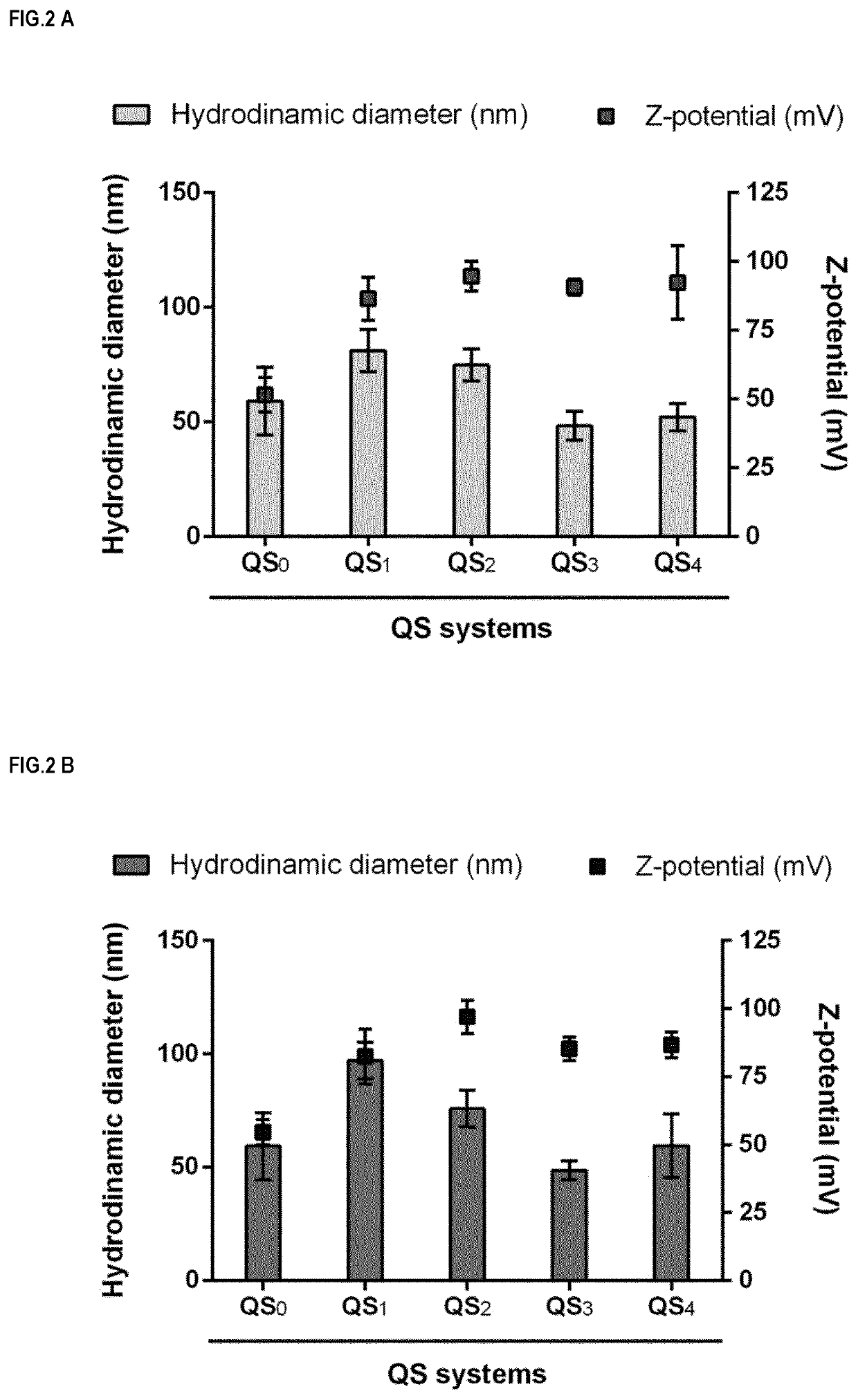Nanovesicles and its use for nucleic acid delivery
a technology of nucleic acid delivery and nanoparticles, applied in the field of nanoparticles, can solve the problem of vivo administration still a challeng
- Summary
- Abstract
- Description
- Claims
- Application Information
AI Technical Summary
Benefits of technology
Problems solved by technology
Method used
Image
Examples
examples
1. Quatsomes Synthesis
1.1 Quatsomes Synthesis and Physicochemical Characterisation
Materials and Methods
[0144]Cholesten-3β-ol (Choi, purity 95%; #A0807; CAS n°: 57-88-5) and Sodium hydroxide (NaOH, purity 98.0%) were obtained from PanReac (Castellar del Valles, Spain). Cholesteryl N-(2-dimethylaminoethyl)carbamate (DC-Chol, purity 98%; #92243) and Cholesteryl hemisuccinate (Chems, purity 98%; #06512; CAS n°: 1510-21-0) were purchased from Sigma-Aldrich (Saint Louis, Mo., USA). Benzyldimethyltetradecylammonium Chloride (MKC; purity 99%; #262393) was supplied by AttendBio Research SL (Santa Coloma de Gramenet, Spain). Cetyltrimethylammonium bromide (CTAB, ultra for molecular biology) was purchased from Fluka-Aldrich. 1,1′-dioctadecyl-3,3,3′,3′-tetramethyl-indocarbocyanine perchlorate (Dil) was supplied by Thermofisher. Ethanol was purchased from Teknochroma (Sant Cugat del Vallès, Spain). The Polyethyleneglycol derivatives of cholesterol (mPEG-CLS; mPEG chain: 1000; #MF001095-1K) were ...
example 3
omplex Formation
Materials and Methods:
[0170]QS-sRNA complexes were formulated by mixing QS and small RNA (sRNA) at different sRNA-to-QS mass ratios (w / w) called QS-sRNA loadings. First of all, for in vitro experiments, QS were diluted in Depc treated water (ThermoFisher; #750024) to achieve the desired concentrations, such as 3.98 mg / mL for QS0; 1.15 mg / mL for QS1; 1.76 mg / mL for QS2; 1.88 mg / mL for QS3 and 1.99 mg / mL for QS4. To form QS-sRNA complexes, 2.5 μL of sRNA were added over the appropriate volume (μL) of QS solution to obtain the desired sRNA-to-QS mass ratios (w / w), and maintaining a constant sRNA concentration (see Table 7). To achieve a constant final concentration of sRNA (2.5 μM), QS-sRNA complexes were diluted with PBS 1× until reach the desired final volume (i.e. 20 μL), then mixed by pipetting twice up-down (less than five minutes of incubation). The resulting QS-sRNA complexes were generated by ionic interactions between the positive charges on the surface of QS a...
example 4
ility Study
Materials and Methods:
Cell Cultures
[0175]SK-N-BE(2) were acquired from Public Health England Culture Collections (Salisbury, UK) and stored in liquid nitrogen. Upon resuscitation, SK-N-BE(2) cells were cultured in Iscove's modified Dulbecco's Medium (Life Technologies, Thermo Fisher Scientific, Waltham, Mass., USA), supplemented with 10% heat-inactivated foetal bovine serum (FBS) South America Premium, 1% of Insulin-Transferrin-Selenium Supplement (Life Technologies, Thermo Fisher Scientific), 100 U / mL penicillin, 100 μg / mL streptomycin (Life Technologies, Thermo Fisher Scientific) and 5 μg / mL plasmocin (InvivoGen, San Diego, Calif., USA). All cultures were maintained at 37° C. in a saturated atmosphere of 95% air and 5% CO2. SK-N-BE(2) cells were tested for mycoplasma contamination periodically.
[0176]For in vitro experiments, SK-N-BE(2) neuroblastoma cells were reverse transfected with the addition of the QS-sRNA complexes to complete cell culture medium (IMDM, 10% heat-...
PUM
| Property | Measurement | Unit |
|---|---|---|
| diameter | aaaaa | aaaaa |
| mass ratios | aaaaa | aaaaa |
| diameter | aaaaa | aaaaa |
Abstract
Description
Claims
Application Information
 Login to View More
Login to View More - R&D
- Intellectual Property
- Life Sciences
- Materials
- Tech Scout
- Unparalleled Data Quality
- Higher Quality Content
- 60% Fewer Hallucinations
Browse by: Latest US Patents, China's latest patents, Technical Efficacy Thesaurus, Application Domain, Technology Topic, Popular Technical Reports.
© 2025 PatSnap. All rights reserved.Legal|Privacy policy|Modern Slavery Act Transparency Statement|Sitemap|About US| Contact US: help@patsnap.com



